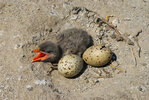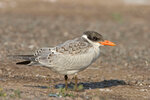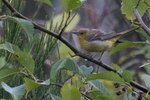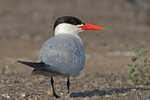



I wrote a column in July about encountering a small flock of Caspian Terns on the mudflats north of the Port of Olympia. Terns are fish-eating birds with white bodies and black wings; most are relatively small and a challenge to identify. Caspian Terns are easy to identify. They are the largest of all terns, with bodies of 20+ inches and a wingspan of 4+ ft. Despite their large size, they fly with light, airy wings; also, they have a large orangish-red bill and frequently vocalize with a loud harsh squawk.
Although we think of them as sea birds, they breed in a wide variety of aquatic habitats worldwide. Their key need is abundant fish to feed their young. They migrate to warmer areas in winter, returning to breeding sites in mid-spring. In years with poor food supply, their breeding efforts may fail entirely. However, they are long-lived birds, reaching a typical age of 12-15 years once they survive their first year, and therefore one failed breed cycle is not a danger to the species. (This is, incidentally, typical for most sea birds).
When I first started bird watching 40 years ago, Caspian Terns were relatively rare. If you wanted to find them, you had to go to the coast; even then, you might see only a few. In the intervening years, Caspian Terns established breeding colonies at the mouth of the Columbia River and Grays Harbor. In fact, the Columbia River breeding colony was once known as the largest in the world, with an estimated 6000 pairs.
That Columbia River colony was so huge that it became a major threat to endangered Columbia River juvenile salmon during their outmigration. Thus, federal and state authorities initiated a harassment program to discourage nesting and protect the endangered salmon. As a result, Caspian Terns migrated to new breeding locations, including a relatively new location on Rat Island, a sandy spit off Fort Flagler State Park near Port Townsend.
This colony is in a vulnerable location and thus has been monitored closely. This spring an aerial survey conducted by the Washington Department of Fish and Wildlife (WDFW) estimated 1800 adults occupying the colony. Caspian Terns nest using a scrape in sand and gravel and are fairly tolerant of each other, with nests as close as five feet. Adults take turns with nest guarding and feeding their young, typically two.
Trouble was first detected at the Rat Island colony on July 10th. A naturalist counted ten dead terns. WDFW staff visited the island to collect the dead birds for analysis, suspecting bird flu,
highly pathogenic avian influenza (HPAI), caused by the H5N1 virus. This diagnosis was confirmed and by later in the summer, over 2000 dead adults and chicks were collected (and, of course, many others also had died). The fact that these terns nest close together would suggest that the virus, passed by nasal droplets, could devastate a colony very quickly.
There’s a possible rosy lining to this gloomy picture, however. By mid-August there were still several hundred healthy adults and a few chicks present on the island. Studies from Europe suggest that some birds may acquire immunity, thus surviving the initial outbreak and possibly able to return the next year to re-establish the colony. We may be watching first-hand (more or less) an example of how nature adapts to severe difficulties.
Vagrant Update: October is a great month to find vagrants, usually single birds found far from their usual migration path. Washington birders are haunting the various sites in the state where these wanderers collect. Liam, or column photographer, has been to Neah Bay at least twice; overall, he has added at least four species, including an Orchard Oriole to his year list in the last 2-3 weeks. You can track these birders’ findings and learn the location of these vagrant traps, and what species are considered rare, at the Washington Rare Bird Alert.
George Walter is environmental program manager at the Nisqually Indian Tribe’s natural resources department; he also has a 40+ year interest in bird watching. He may be reached at george@theJOLTnews.com
Photos for this column are provided by Liam Hutcheson, a 16-year-old Olympia area birder and avid photographer.
1 comment on this item Please log in to comment by clicking here
Terrilovesanimals
Thank you for sharing this. I learned! I love learning, especially when it's about birds, animals and nature. Glad the terns had many survivors and am praying that they will get their numbers back up soon. Natural immunity is awesome and humans should learn from them! OH, and they are beautiful birds!
Monday, October 23, 2023 Report this